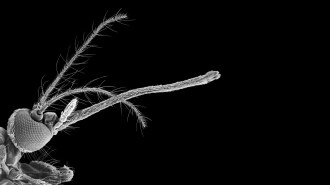- More than 2 years ago
Scientists have created a walking robot out of DNA—a first step toward DNA-based devices that could shuttle molecular cargo around as if on a conveyor belt or assemble other nanoscale machines.
Created by chemists Nadrian Seeman and William Sherman of New York University, the robot and the track it walks along are made entirely of DNA. Each of the device’s two legs has a foot that sits atop a foothold in the straight track. A separate piece of DNA called a set strand attaches to both the foot and the foothold, locking the two units in place.
To move one leg forward, the researchers add an “unset” strand that peels away the set strand and thus releases the leg from the track. The freed leg progresses to the next foothold. Once in place, a different set strand fixes the foot to its new position.
Because a DNA strand will bind to another strand only when their chemical sequences match, the researchers can control the assembly and motion of their DNA robot by carefully designing the parts of each piece of DNA in the system.
As described in the July issue of Nano Letters, the entire bipedal device was created in a test tube containing billions of copies of the tiny robots. So far, the researchers have coerced the robots to take a 2-nanometer-long step forward and then backward. The researchers now plan to design circles, grids, and other pathways for the robots, says Sherman.





